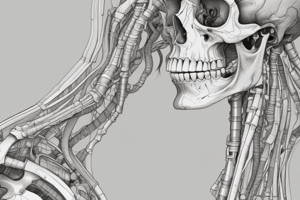Podcast
Questions and Answers
Which bone is categorized as a cranial bone?
Which bone is categorized as a cranial bone?
- Maxilla
- Mandible
- Lacrimal
- Temporal (correct)
What is the function of the anterior fontanelle in a fetal skull?
What is the function of the anterior fontanelle in a fetal skull?
- Provides attachment for muscles
- Facilitates brain growth (correct)
- Enhances auditory functions
- Stabilizes the skull structure
Which of the following is NOT a suture in the skull?
Which of the following is NOT a suture in the skull?
- Zygomatic suture (correct)
- Sagittal suture
- Coronal suture
- Lambdoid suture
Which bone houses the optic canal?
Which bone houses the optic canal?
What is the primary role of the nasal bones?
What is the primary role of the nasal bones?
Which of these bones is part of the facial skeleton?
Which of these bones is part of the facial skeleton?
Which junction point of the skull is located at the intersection of the frontal, parietal, and nasal bones?
Which junction point of the skull is located at the intersection of the frontal, parietal, and nasal bones?
The foramen magnum is primarily associated with which function?
The foramen magnum is primarily associated with which function?
What is the anatomical term for the depressions formed by the cranial fossae?
What is the anatomical term for the depressions formed by the cranial fossae?
Which structure primarily contributes to the formation of the oral cavity?
Which structure primarily contributes to the formation of the oral cavity?
Which bone forms the medial wall of the orbit?
Which bone forms the medial wall of the orbit?
What is the primary function of the hyoid bone?
What is the primary function of the hyoid bone?
Which vertebrae is referred to as the 'vertebra prominens'?
Which vertebrae is referred to as the 'vertebra prominens'?
Which structure is located on the superior surface of the sacrum?
Which structure is located on the superior surface of the sacrum?
Which part is not a component of the thoracic vertebrae?
Which part is not a component of the thoracic vertebrae?
Which of the following is part of the lateral wall of the orbit?
Which of the following is part of the lateral wall of the orbit?
Which cervical vertebra is distinguished by the presence of the dens?
Which cervical vertebra is distinguished by the presence of the dens?
Which rib is classified as an atypical rib?
Which rib is classified as an atypical rib?
What is the main role of the anterior longitudinal ligament?
What is the main role of the anterior longitudinal ligament?
Where is the xiphoid process located?
Where is the xiphoid process located?
Which type of ribs are known as floating ribs?
Which type of ribs are known as floating ribs?
Which structure forms the posterior wall of the pelvis?
Which structure forms the posterior wall of the pelvis?
Which is not found in the structure of the lower vertebral column?
Which is not found in the structure of the lower vertebral column?
What is the purpose of the intercostal spaces?
What is the purpose of the intercostal spaces?
Flashcards are hidden until you start studying
Study Notes
Axial Skeleton Overview
- Divided into cranial and facial bones.
- Total cranial bones: 8 (Ethmoid, Frontal, Occipital, Parietal, Sphenoid, Temporal).
- Total facial bones: 14 (Lacrimal, Mandible, Maxilla, Nasal, Vomer, Zygomatic, plus Inferior nasal concha and Palatine not shown).
Fetal Skull Development
- Contains soft spots known as fontanelles: Anterior, Mastoid, Metopic, Posterior, and Sphenoidal.
- Fontanelles allow for brain growth and skull shape change during birth.
Sutures and Junctions
- Major sutures: Coronal, Lambdoid, and Sagittal, connecting cranial bones.
- Junction points significant for anatomical reference: Asterion, Bregma, Lambda.
Anterior Skull Anatomy
- Frontal bone features: Squamous part, Supraorbital margin, and Foremen.
- Sphenoid bone includes Greater wing, Inferior and Superior orbital fissures, and Optic canal.
- Ethmoid bone elements: Orbital part, Middle nasal concha, and Perpendicular plate.
- Junction points: Nasion and Pterion.
Lateral Skull View
- Temporal bone includes External acoustic meatus, Mastoid process, Zygomatic process.
- Mandible anatomy: Alveolar process, Angle, Body, and various processes.
- Zygomatic bone features contributions to the orbit structure.
Skull Cavities and Sinuses
- Major cavities include the Cranial cavity and various sinuses: Ethmoidal, Frontal, Maxillary, Sphenoidal.
- Other cavities include the Nasal and Oral cavities, as well as the Orbit.
Cranial Base and Passageways
- Key structures: Cribriform foramina, Foramen magnum, Jugular foramen, Optic canal.
- Important for nervous system and vascular pathways.
Vertebral Anatomy
- Cervical vertebrae include C1 (Atlas) and C2 (Axis), with C2 noted for the Dens (Odontoid process).
- Features of C4, C7, and other significant vertebrae types like thoracic (T4, T5) and lumbar (L3) vertebrae.
- Sacrum's anatomy includes Anterior sacral foramen and the Apex, while the Coccyx consists of multiple fused vertebrae.
Vertebral Support Structures
- Various ligaments support the vertebral column: Anterior and Posterior longitudinal ligaments, Interspinous ligament, Ligamentum flavum, Supraspinous ligament.
Sternum and Rib Anatomy
- Sternum consists of three parts: Manubrium, Body, and Xiphoid process.
- Ribs classified as true, false, and floating: true ribs connect directly to the sternum, false ribs connect indirectly, and floating ribs have no attachment to the sternum.
Atypical Rib Structures
- Ribs T1, T2 are atypical due to additional features compared to typical ribs T3-T9.
- T11 and T12 exhibit unique characteristics distinguishing them from true ribs.
Isolated Bone Identification
- Key isolated bones to know: Ethmoid, Maxilla, Sphenoid, Zygomatic, Frontal, Mandible, Occipital, Parietal, Temporal.
- Familiarize with bone markings and anatomical positions across different views.
These notes encapsulate the essential aspects of the axial skeleton covered in the laboratory session, serving as a useful reference for study and examination preparation.
Studying That Suits You
Use AI to generate personalized quizzes and flashcards to suit your learning preferences.




